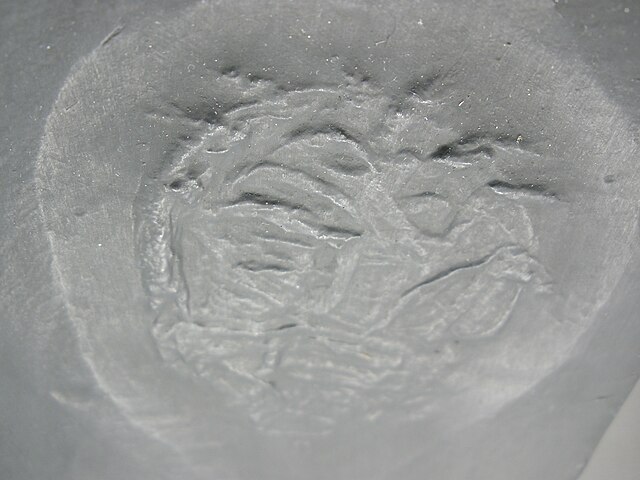Loading AI tools
Extinct genus of chelicerate From Wikipedia, the free encyclopedia
Weinbergina is a genus of synziphosurine,[1][2] a paraphyletic group of fossil chelicerate arthropods.[3][4] Fossils of the single and type species, W. opitzi, have been discovered in deposits of the Devonian period in the Hunsrück Slate, Germany.[2]
| Weinbergina Temporal range: | |
|---|---|
 | |
| Fossil of Weinbergina opitzi, Naturmuseum Senckenberg | |
 | |
| Reconstruction | |
| Scientific classification | |
| Domain: | Eukaryota |
| Kingdom: | Animalia |
| Phylum: | Arthropoda |
| Subphylum: | Chelicerata |
| Clade: | Euchelicerata |
| Genus: | †Weinbergina Richter & Richter, 1929 |
| Type species | |
| †Weinbergina opitzi Richter & Richter, 1929 | |
Weinbergina is a relatively large synziphosurine, ranging about 7 cm to 10 cm in full body length.[2] The prosoma is covered by a semicircular carapace with blunt genal cornua (posterolateral corners).[2] There is possible evidence of lateral eyes located just below the ophthalmic ridges.[1] The opisthosoma is externally 10-segmented, expressed by tergites that possess blunt tergopleurae (lateral extension) and axial nodes. However, the opisthosoma is most likely 11-segmented in origin,[5] with the first segment being highly reduced (a synapomorphy of euchelicerates[3]) and possibly covered by the preceding carapace.[1][2] The last 3 segments form a narrow postabdomen and lacking lateral nodes.[1][2]

Compared to other synziphosurines with only scarce or no discovery of any evidence of appendages, the appendages of Weinbergina are exceptionally well-preserved in many described fossil materials.[1][2] Underneath the carapace are small chelicerae and pairs of well-developed, 8-segmented walking legs.[1][2] Each of the distal leg podomeres (segmental units) bore numerous spines-like projections, forming a snow-shoe-like termination.[1][2] The opisthosoma possess (possibly 6[5]) pairs of opercula with setose distal regions and possible evidence of book gills.[1][2]
Based on the interpretation of Stürmer & Bergström (1981) and Moore, Briggs & Bartels (2005), Weinbergina is unusual in having 6 pairs of walking legs instead of 5 or less like those of other euchelicerates.[1][2][5] The additional 6th leg pair was regarded to be originated from somite 7 (1st opisthosomal segment), thus homologous with the chilaria of horseshoe crab, metastoma of dekatriatan and 4th walking legs of sea spider.[2][3][5] However, the twelve-legged interpretation is not universally accepted - for example, Weinbergina was originally described as ten-legged like extant horseshoe crab;[2] Selden, Lamsdell & Qi (2015) noted that the structures previously identified as distal regions of walking legs may be in fact leg-like exopods like those of Offacolus and Dibasterium, while the actual terminations of walking legs (endopods) are chelate (pincer) like those of horseshoe crabs.[5][6]
Weinbergina may have been a benthic animal with some degree of swimming ability, similar to modern horseshoe crabs.[1] However, the lack of doublure (ventral thickening run through the margin of carapace) suggests that Weinbergina is not adapted for a sediment-dwelling lifestyle as seen in the modern horseshoe crab.[1] Under the questionable[6] 12-legged interpretation, the legs with snow-shoe-like terminations instead of chela are also more adapted for walking on fine-grained surface instead of searching food items beneath the sediment.[1][2]
With Weinbergina as type genus, Weinbergina, Legrandella and Willwerathia were once united under the single family Weinberginidae,[2] an interpretation which is not recovered by later phylogenetic analysis.[6][7][8] After the revision of relationship between synziphosurines and other euchelicerates done by Lamsdell 2013,[3] Weinbergina was regarded as the basalmost member of Prosomapoda, a clade that included all euchelicerates except Offacolus and Dibasterium.[4][6][7][9][8][10]
Seamless Wikipedia browsing. On steroids.
Every time you click a link to Wikipedia, Wiktionary or Wikiquote in your browser's search results, it will show the modern Wikiwand interface.
Wikiwand extension is a five stars, simple, with minimum permission required to keep your browsing private, safe and transparent.